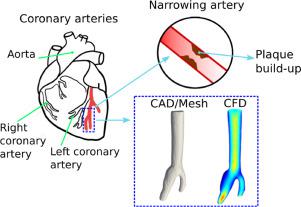International Journal of Mechanical Sciences ( IF 7.1 ) Pub Date : 2021-09-04 , DOI: 10.1016/j.ijmecsci.2021.106780 Konstantinos G. Lyras 1 , Jack Lee 1

|
The fluid dynamics of occluded arteries depends on many physiological factors and the resulting complexity of the post-stenotic flow field present a challenge for numerical solvers. The primary goal of this paper is to assess the performance of non-commercial and academic CFD solvers that have not been compared previously, for the purpose of stenosed arterial flow modelling. We evaluated Heart, Crimson, Nektar++ and OpenFOAM which altogether employ a wide range of algorithms, including finite element and finite volume methods, coupled and segregated pressure-velocity solves, implicit and explicit time stepping, and varying spatial discretization orders. Furthermore, improved realism in test scenarios was achieved, in which three representative artery geometries of increasing complexity were employed with time-dependent boundary conditions. In the simplest geometry, codes that employed explicit stepping and segregated solve yielded an equivalent accuracy within shorter computational times regardless of whether FEM or FVM was used. However, the disagreements between solver predictions grew in more complex geometries with increasing mesh refinement (by with grid points), reaching a level ( in ) which is unsuitable for clinical purposes. We conclude that while accelerated schemes are safe to use in the lower simpler stenotic arteries, the choice of a CFD solver is likely to affect the clinical recommendation in the general diseased arteries, and should be made with application-specific considerations.
中文翻译:

模拟通过动脉狭窄的流动的数值实现的比较
闭塞动脉的流体动力学取决于许多生理因素,由此产生的狭窄后流场的复杂性对数值求解器提出了挑战。本文的主要目标是评估之前未进行比较的非商业和学术 CFD 求解器的性能,以用于狭窄动脉血流建模。我们评估了Heart、Crimson、Nektar++ 和 OpenFOAM 共同采用了广泛的算法,包括有限元和有限体积方法、耦合和分离的压力-速度求解、隐式和显式时间步长以及变化的空间离散化阶数。此外,在测试场景中实现了改进的真实性,其中三个具有增加复杂性的代表性动脉几何形状与时间相关的边界条件一起使用。在最简单的几何中,无论使用 FEM 还是 FVM,采用显式步进和分离求解的代码在更短的计算时间内产生了等效的精度。然而,随着网格细化程度的增加(通过 和 网格点),达到一个水平( 在 ) 不适用于临床目的。我们得出的结论是,虽然加速计划在较低的情况下使用是安全的 对于较简单的狭窄动脉,CFD 求解器的选择可能会影响一般病变动脉的临床建议,应结合应用程序特定考虑。











































 京公网安备 11010802027423号
京公网安备 11010802027423号